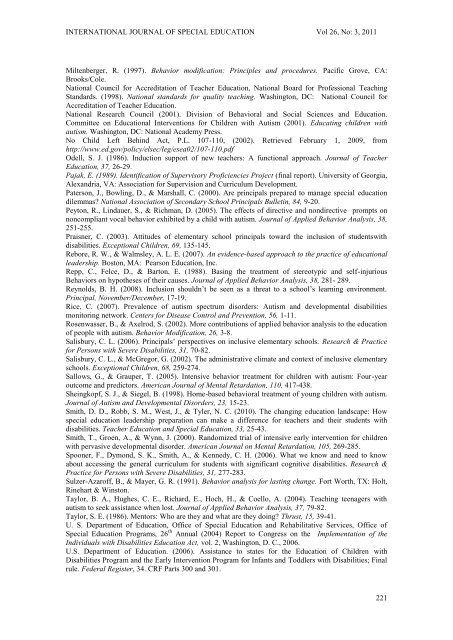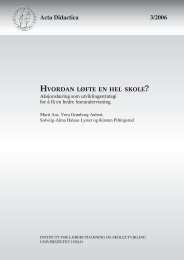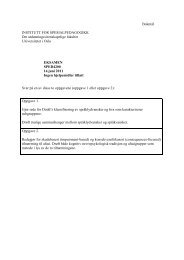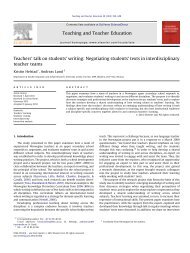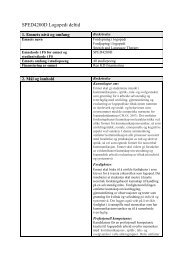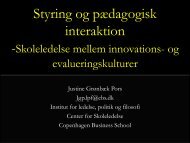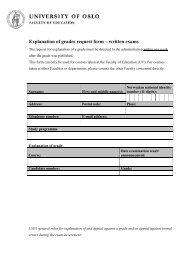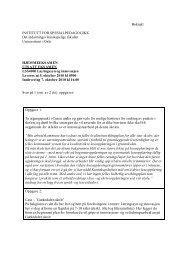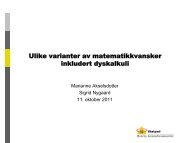International Journal Special Education
International Journal Special Education
International Journal Special Education
You also want an ePaper? Increase the reach of your titles
YUMPU automatically turns print PDFs into web optimized ePapers that Google loves.
INTERNATIONAL JOURNAL OF SPECIAL EDUCATION Vol 26, No: 3, 2011Miltenberger, R. (1997). Behavior modification: Principles and procedures. Pacific Grove, CA:Brooks/Cole.National Council for Accreditation of Teacher <strong>Education</strong>, National Board for Professional TeachingStandards. (1998). National standards for quality teaching. Washington, DC: National Council forAccreditation of Teacher <strong>Education</strong>.National Research Council (2001). Division of Behavioral and Social Sciences and <strong>Education</strong>.Committee on <strong>Education</strong>al Interventions for Children with Autism (2001). Educating children withautism. Washington, DC: National Academy Press.No Child Left Behind Act, P.L. 107-110, (2002). Retrieved February 1, 2009, fromhttp://www.ed.gov/policy/elsec/leg/esea02/107-110.pdfOdell, S. J. (1986). Induction support of new teachers: A functional approach. <strong>Journal</strong> of Teacher<strong>Education</strong>, 37, 26-29.Pajak, E. (1989). Identification of Supervisory Proficiencies Project (final report). University of Georgia,Alexandria, VA: Association for Supervision and Curriculum Development.Paterson, J., Bowling, D., & Marshall, C. (2000). Are principals prepared to manage special educationdilemmas? National Association of Secondary School Principals Bulletin, 84, 9-20.Peyton, R., Lindauer, S., & Richman, D. (2005). The effects of directive and nondirective prompts onnoncompliant vocal behavior exhibited by a child with autism. <strong>Journal</strong> of Applied Behavior Analysis, 38,251-255.Praisner, C. (2003). Attitudes of elementary school principals toward the inclusion of studentswithdisabilities. Exceptional Children, 69, 135-145.Rebore, R. W., & Walmsley, A. L. E. (2007). An evidence-based approach to the practice of educationalleadership. Boston, MA: Pearson <strong>Education</strong>, Inc.Repp, C., Felce, D., & Barton, E. (1988). Basing the treatment of stereotypic and self-injuriousBehaviors on hypotheses of their causes. <strong>Journal</strong> of Applied Behavior Analysis, 38, 281- 289.Reynolds, B. H. (2008). Inclusion shouldn’t be seen as a threat to a school’s learning environment.Principal, November/December, 17-19.Rice, C. (2007). Prevalence of autism spectrum disorders: Autism and developmental disabilitiesmonitoring network. Centers for Disease Control and Prevention, 56, 1-11.Rosenwasser, B., & Axelrod, S. (2002). More contributions of applied behavior analysis to the educationof people with autism. Behavior Modification, 26, 3-8.Salisbury, C. L. (2006). Principals’ perspectives on inclusive elementary schools. Research & Practicefor Persons with Severe Disabilities, 31, 70-82.Salisbury, C. L., & McGregor, G. (2002). The administrative climate and context of inclusive elementaryschools. Exceptional Children, 68, 259-274.Sallows, G., & Grauper, T. (2005). Intensive behavior treatment for children with autism: Four-yearoutcome and predictors. American <strong>Journal</strong> of Mental Retardation, 110, 417-438.Sheingkopf, S. J., & Siegel, B. (1998). Home-based behavioral treatment of young children with autism.<strong>Journal</strong> of Autism and Developmental Disorders, 23, 15-23.Smith, D. D., Robb, S. M., West, J., & Tyler, N. C. (2010). The changing education landscape: Howspecial education leadership preparation can make a difference for teachers and their students withdisabilities. Teacher <strong>Education</strong> and <strong>Special</strong> <strong>Education</strong>, 33, 25-43.Smith, T., Groen, A., & Wynn, J. (2000). Randomized trial of intensive early intervention for childrenwith pervasive developmental disorder. American <strong>Journal</strong> on Mental Retardation, 105, 269-285.Spooner, F., Dymond, S. K., Smith, A., & Kennedy, C. H. (2006). What we know and need to knowabout accessing the general curriculum for students with significant cognitive disabilities. Research &Practice for Persons with Severe Disabilities, 31, 277-283.Sulzer-Azaroff, B., & Mayer, G. R. (1991). Behavior analysis for lasting change. Fort Worth, TX: Holt,Rinehart & Winston.Taylor, B. A., Hughes, C. E., Richard, E., Hoch, H., & Coello, A. (2004). Teaching teenagers withautism to seek assistance when lost. <strong>Journal</strong> of Applied Behavior Analysis, 37, 79-82.Taylor, S. E. (1986). Mentors: Who are they and what are they doing? Thrust, 15, 39-41.U. S. Department of <strong>Education</strong>, Office of <strong>Special</strong> <strong>Education</strong> and Rehabilitative Services, Office of<strong>Special</strong> <strong>Education</strong> Programs, 26 th Annual (2004) Report to Congress on the Implementation of theIndividuals with Disabilities <strong>Education</strong> Act, vol. 2, Washington, D. C., 2006.U.S. Department of <strong>Education</strong>. (2006). Assistance to states for the <strong>Education</strong> of Children withDisabilities Program and the Early Intervention Program for Infants and Toddlers with Disabilities; Finalrule. Federal Register, 34. CRF Parts 300 and 301.221


